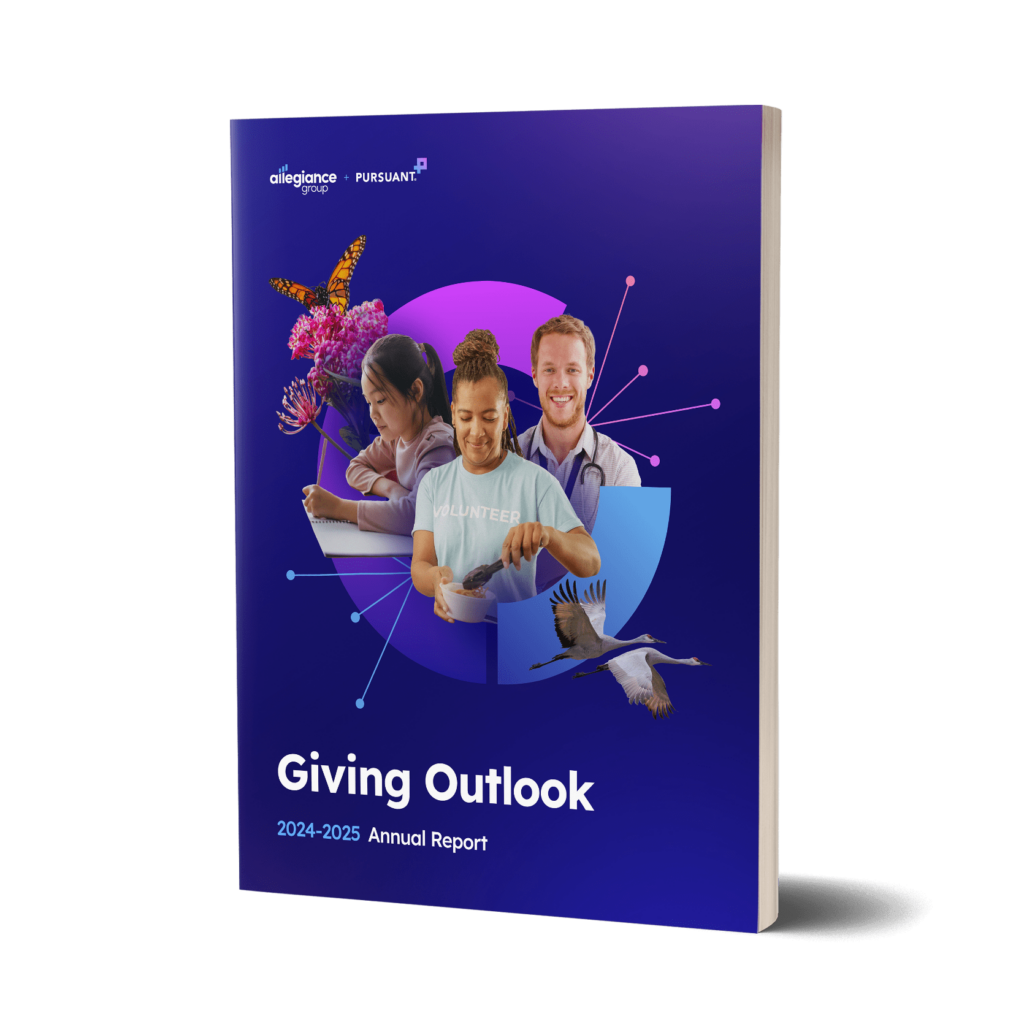2025 Predictions for Nonprofits

On the heels of a record-breaking Giving Tuesday, nonprofits appear to be on track to see increases in year-end and overall giving. Could these gains be teeing up more growth in 2025?
Giving is expected to increase by 3.9% in 2025, fueled partly by anticipated rises in personal income and net worth. Stock market gains could also mean more individual million-dollar gifts to charity and substantial revenue for foundations. However, gaps persist between the median income for households of different racial backgrounds. Simply put, your potential donors’ personal experiences will vary widely.
In this guide, we share our experts’ predictions on what nonprofits may expect in 2025. We’ll also outline action items to help you prepare for the year ahead and navigate any potential bumps in the road.
Set your organization up for a year of fundraising success.
Prediction 1: Positive Economic Indicators
While uncertainty loomed over 2024, uptrends in several economic factors lend optimism to 2025. For instance, according to the Bureau of Economic Analysis (BEA), personal income grew 5.3% year-over-year (YOY) to $315.6 billion in Q2 of 2024, and earnings increased to 6.3%.
Household net worth hit a new record level in Q3 of 2024, increasing by 2.9%. Disposable income also rose during this time by 2.6% YOY. And while the national unemployment rate ticked slightly up YOY, it still sits at a relatively low 4.2%.
What does all this mean for nonprofits? The projection for giving by individuals and households is expected to surpass the historical 10-, 25-, and 40-year annualized average growth rates. With more money in their pockets, we predict donors will pass those additional dollars on to their charities of choice.
The stock market is another economic indicator to watch. At the end of November 2024, the S&P 500 was up about 26%, and experts believe it will rise about 8% more next year. If this growth continues, foundations and corporations should be able to invest more in philanthropy.
Action Item: Learn More About Where Your Support Comes From
These positive economic trends are only a guide. Knowing precisely where your gifts come from is critical to forecasting how successful your 2025 might be.
Take this example: According to the U.S. Census Bureau, in 2023, white and non-Hispanic white households saw their incomes increase by 5.4% and 5.7%, respectively, YOY. However, there was no significant change in the incomes for Black, Asian, and Hispanic households. If you rely on a community of color for support, they may simply have less disposable income to give right now — despite a soaring economy.
The truth is, you won’t know what to expect in 2025 until you know who your donors are. A tool like the Allegiance Group + Pursuant GivingDNA platform can help you identify key audiences within your donor database and segment them based on motivations, behaviors, and demographic information, including ethnicity. You can then dig deeper into wealth indicators to learn about how they may be faring in today’s economy so you can tailor an appeal that makes sense for their specific situation.

Navigate this year’s fundraising landscape with our 2024-2025 Giving Outlook eBook.
Prediction 2: Widening Giving Gaps
Philanthropy is increasingly dependent on higher-dollar donors. One recent report found that those worth $30 million or more account for 38% of all individual giving. But it’s not just the ultra-wealthy that drive giving — in general, 20% of higher-earning households ($150,000+) are responsible for 80% of a nonprofit’s donations.
It’s no wonder that fundraisers tend to focus on donors with the potential for significant gifts. A strong economy may compel fundraisers to prioritize major and supersize donors even more. However, they do so at the risk of alienating supporters further down in the donor pyramid.
Donations from micro donors — those who give $100 or less — decreased by 12.3% in Q2 of 2024 YOY, the largest drop among donor segments. The number of supersize donors who give $50,000 or more fell the least, by 2.7%. This is notable because micro donors comprise 53.7% of all donors versus the 0.3% that are supersized donors.
Not to mention that if the stock market takes a tumble, the wealthy donors you rely on may be less willing to part with their assets. This could leave you in a serious pinch.
Action Item: Appeal to the Entire Pyramid
By focusing on high-dollar gifts, it’s easy to neglect lower-level and potential new donors. The solution? Appeal to the entire donor pyramid.
Look for ways to attract and cultivate new donors, then steward them appropriately to encourage multiple gifts. A tool like GivingDNA can help you determine which lower-level donors might be good candidates to become recurring or monthly donors. Work to establish trust with your audience and reengage supporters who may have dropped off your list.
If you face short-term cuts, resist the urge to eliminate outreach aimed at lower-level donors. Instead, lean on your data to learn which segments show the greatest giving potential and focus your efforts there.
This is a long game — the goal is to build relationships that will support you for 20 years, not necessarily lead to a large donation in 20 months. Remember, many of your major donors likely began with a small gift.
Prediction 3: Continued Uncertainty
A certain level of uncertainty often follows a presidential election, particularly when a new party takes control. While it’s too early to know what policies will be enacted, experts have raised concerns about the potential impacts of House Republican budget plans. For instance:
- Policies could increase costs while reducing access to health coverage and food assistance, which might contribute to economic and health insecurity, potentially leading to higher poverty rates.
- Some budget plans propose cuts to federal public services, including transportation infrastructure and scientific and medical research.
- Proposed budget plans suggest extending tax laws from the Trump administration, which could offer cuts for wealthy households and corporations. Critics argue that this could exacerbate the wealth gap.
- Some immigration policies would reduce support for immigrants and propose denying public benefits to individuals who are not U.S. citizens.
Although it remains uncertain whether these policies will move forward, some organizations might uncover new possibilities under the incoming administration. However, if certain social safety nets are removed, nonprofit services could be in higher demand than ever.
Federal grants for nonprofits could also be affected. Following the election, GrantWatch released a comprehensive list of what grant-seeking nonprofits can expect based on Trump’s first term. Depending on their focus, some organizations may see fewer grant opportunities, while others could see new opportunities arise.
Action Item: Diversify Your Funding
If you rely heavily on federal grants to operate, now is the time to reduce that dependency. Private grants, state funding, and partnerships can help you remain stable amid shifting federal priorities, as can shoring up your donor database. For instance, prioritizing recurring or monthly gifts can provide dependable funding for your operations.
Moreover, diversifying your portfolio will strengthen your organization. You’ll be better able to adapt to the changing needs of those you serve while building brand resilience and long-term stability.
Diverse funding sources will also encourage innovation and growth. Whereas government grants could limit your programs to those that align with strict priorities, multiple revenue streams give you the leeway to experiment with projects that could be more impactful.
Check your donor and program data throughout the year to ensure you meet the needs of those you support.
Consider taking these steps:
- Audit your donor file to assess the readiness of a mid-level giving program
- Conduct a file analysis to determine the source and cultivation period of past major gifts
- Explore how a giving day could encourage giving from multiple constituencies
Knowing what’s working and where opportunities lie will enable you to pivot as needed.
Conclusion
2025 offers great potential for nonprofits to boost their impact. At this point, we expect charitable giving to continue increasing amid gains in individuals’ wages and household disposable income.
Of course, the new year won’t be without some roadblocks. To navigate them successfully, don’t depend too much on one or two primary sources of revenue. Build up lower-level donors to engender long-term support and diversify where your primary funding comes from. Most importantly, let data guide your decisions. In doing so, your organization will be more flexible and better able to fulfill its mission.
We would love to help you prepare for 2025 and beyond. Download our free 2024-2025 Giving Outlook today to learn how to align your organization with donor expectations, embrace new giving patterns, and strengthen your strategic agility.